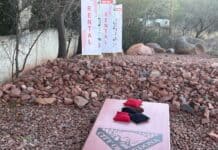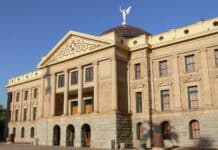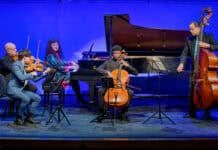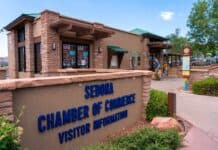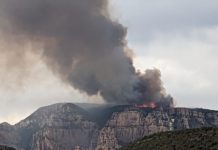Some of Sedona’s biggest attractions are the four vortexes, or vortices, which all offer far-reaching views of the surrounding area, and for their most spiritual visitors, the sought-after energy.
Only one of them, Boynton Canyon, has a feature that can go unnoticed unless inquiring hikers know what they are looking for, and where. Ancient Sinagua ruins provide an elevated view of the surrounding Secret Canyon Wilderness Area, and can be visited at the only vortex located in the West Sedona area of the red rock trail system.
“It was really nice, I hiked up to this little crevice and it was nice and dark, and I sat there for a while. It was really beautiful,” said Faith Swickard of Davis, Calif., a first-time visitor. “The little thing I was sitting in, which was really nice, and I could sit in the shade and no one was around, which was nice. It was really high up, so I could view a lot of things, and it was really beautiful.”
About two and a half miles of mostly flat and narrow trail lead to the area where the acclaimed heightened levels of energy are found. Near the beginning of the trail is a pillar-shaped vista that can be scaled, offering a bird’s eye view of the surroundings.
Swickard and Alison Bartlett were visiting all four vortexes, or vortices, on Saturday, June 30, and preferred Boynton Canyon to Cathedral Rock and Bell Rock, but had not yet gone to Airport Mesa.
The hike can be as easy or as challenging as hikers wish. There are a number of paths to be taken, allowing visitors to stay as little or as long as they would like. All of the vortexes, or vortices, have similar characteristics: A hike and photogenic vistas.
“I found this hike to actually be pretty meditative because it was pretty flat, but also circuitous,” said Bartlett, an Ontario, Canada native. “I could just kind of walk without thinking about it too much, and I just enjoyed [it]. I didn’t really know if it was going to end or where I was going.
“It was nice in that respect, where you could just zone out and just kind of [put] one foot in front of the other.”
Boynton Canyon offers a little bit of a different experience; all visitors have to do is keep from gawking at the red and sand colored walls to one side, and the high-end Enchantment Resort’s lavish homes on the other.
It is important to have vigilant eyes and ears because there is always the possibility of running into a rattlesnake, especially near dusk.
Not plainly obvious at first glance, the Sinagua ruins are tucked high up into the canyon walls. It is not illegal to visit these areas, but it is a federal offense to remove anything from them.
These ruins do not stand out from below, but are actually situated on large ledges underneath a rock overhang. The walls are built of stacked rocks, and if it were raining, visitors would not get wet. With the impending monsoon, it could make for a fun destination to watch storms and rainfall, but beware that the trail leading up is riddled with loose rocks and prickly pear cactus.
Entrance to the first set of these areas can easily go unperceived as well. About a mile into the hike on Trail 47 — which begins by heading left at the fork found at the original trailhead — the path begins heading west, and there is a set of elongated steps with wooden slabs on their edges.
After the fourth step, past a small amount of brush, is a visible splash of red earth — the beginning of a trail that leads upward. Reaching the trail sign further down the main path that reads “Boynton Canyon Trailhead Parking Lot” and “Boynton Canyon” means that inquiring hikers have gone too far. As a landmark, the sign is next to the end of an Enchantment cul-de-sac.
This offshoot is a clearly marked path, but a challenging one. The surrounding shrubbery is overgrown and can catch loose clothing, but is navigable nonetheless.
It is challenging as well, requiring a lot of uphill climbing up rock step-ups and across rock ledges. The effort is worth the reward.
“It’s kind of interesting because when we first got here, it was like, ‘Oh the views are amazing,’ and then after a while they just become expected to a certain degree …. Just looking up and realizing again that you’re surrounded by these mass amounts of rock is something that — being from Ontario, which is very flat — is something that you would never see,” Bartlett said. “I’ve never seen anything like this: Cacti, desert species, like great, love.”
Walking along the ridge of the first ruins, and through a small hole in the rock, hikers can reach a second ruin. Once through the hole and up the mountainside, another wall identical to the first is found. Above that is a ledge that provides a 270-degree view.
The main trail wraps around the canyon from one side of Enchantment to the other, and the high canyon walls accompany hikers nearly from start to finish. The trail is relatively flat, but there are stretches of mixed terrain that includes flat and smooth rock typical of the area, and some step-ups.
Since it is a wilderness area, no mountain bikes are allowed. Given the vista, ruins, the choose-your-difficulty type of trail and dedicated parking lot, it is one of the most popular hikes during peak tourist seasons.
Getting There
Drive north on Dry Creek Road from State Route 89A. Turn left onto Boynton Pass Road, then right onto Boynton Canyon Road. The parking lot is on the right hand side soon after the right hand turn.
The trailhead is back towards the street, across from the bathroom. A Red Rock pass is required to park. Daily passes are $5, weekly passes are $15 and annual passes are $20.



